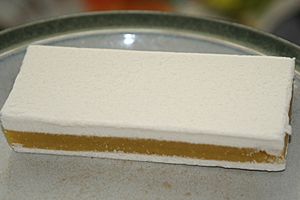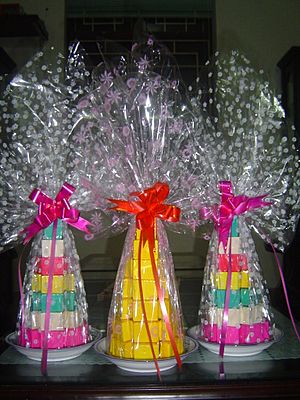Bánh in facts for kids

Sweet rice flour with durian filling (bánh in nhân sầu riêng)
|
|
| Place of origin | Vietnam |
|---|---|
| Region or state | Huế |
Bánh in is a special Vietnamese cake. It's often enjoyed during important celebrations. This sweet treat comes from the beautiful city of Huế in Vietnam. It's known for its unique texture and often has special symbols stamped on it.
Contents
What is Bánh in?
Bánh in is a type of Vietnamese cake. The name "bánh in" means "seal cake." This is because the cakes are often pressed with a special mold. This mold leaves a design or a character on the cake. These characters are usually Sino-Vietnamese symbols. They often bring good luck or wishes for a long life. For example, the character "tho" means long life.
Where Does Bánh in Come From?
This delicious cake has its roots in the city of Huế. Huế is a historic city in central Vietnam. It was once the imperial capital. This area is famous for its rich culture and amazing food. Bánh in is a traditional part of Huế's culinary heritage.
When Do People Eat Bánh in?
Traditionally, Bánh in is a popular treat during Tết. Tết is the Vietnamese Lunar New Year. It is the most important holiday in Vietnam. Families gather, celebrate, and share special foods. Bánh in is a symbol of good fortune and happiness during this time. While it's a Tết favorite, you can now find Bánh in all year round. Many Asian grocery stores around the world sell it. It often comes in smaller, rectangular snack packs.
What's Inside Bánh in?
Bánh in has a few main ingredients. The base is usually rice flour. This gives the cake its soft, powdery texture. Another key ingredient is mung bean. Mung beans are often made into a sweet paste. This paste forms the filling of the cake. Sometimes, a strong-smelling fruit called durian is also added. Durian gives the cake a unique and tropical flavor.


